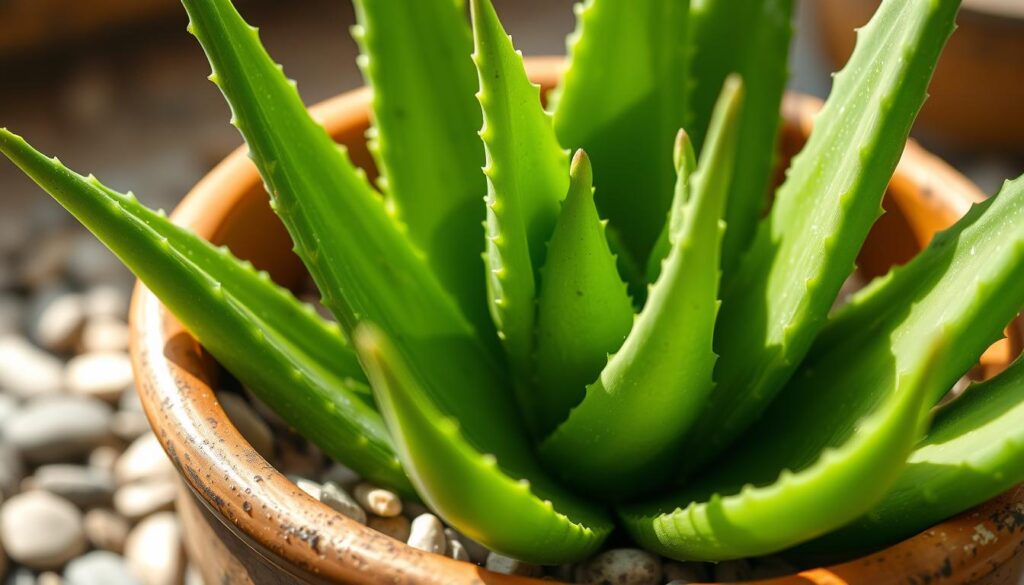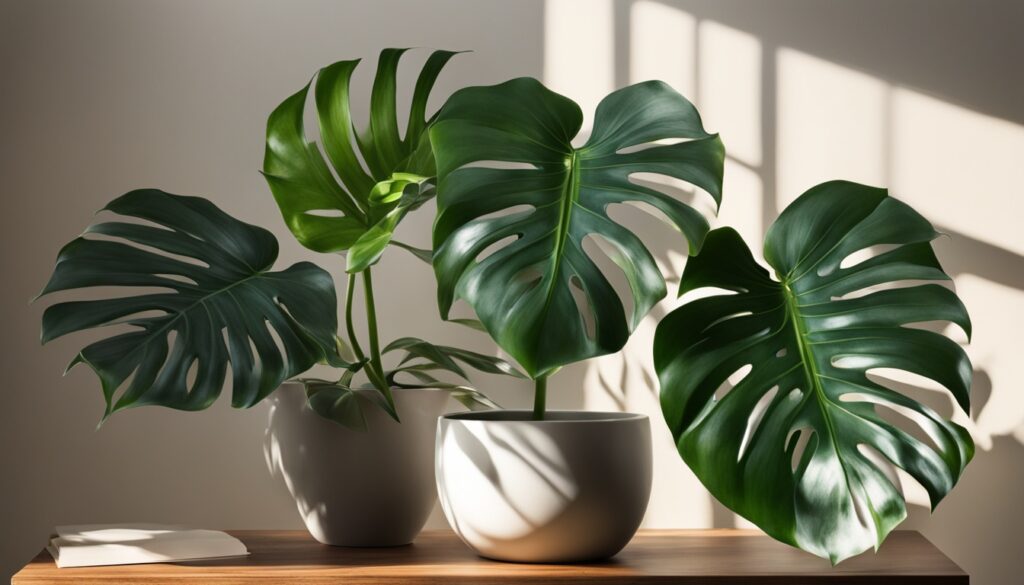Aloe vera plants are popular for their toughness and many uses. They can live up to 100 years and grow up to 3 feet tall with the right care. It’s important to water them just right to keep them healthy.
Even though aloe vera plants come from dry places, they still need regular water. They need a special watering plan to grow well. Too much water can cause root rot and diseases, while too little water makes leaves look bad and stops them from growing.
Key Takeaways
- Aloe vera plants need water about once a week, but less during fall and winter.
- It’s best to check the soil moisture by touch to see if the plant needs water.
- Too much water can cause diseases that can kill the plant, while too little makes leaves turn color and wilt.
- Aloe vera plants like soil that drains well and bright, indirect light to grow best.
- Using deep watering and avoiding overhead watering is key to caring for aloe vera plants.
Understanding Aloe Vera Plant Basics
Aloe vera is a succulent from the Asphodelaceae family. It’s known for its thick leaves and many uses. Found in dry areas of Africa, aloe plants can grow from a few inches to over 5 feet tall and wide. With the right care, they bring greenery and benefits to any space.
Native Habitat and Growth Characteristics
Aloe vera plants love dry, harsh conditions. Their thick leaves hold water, helping them survive in dry places. The leaves come in different patterns, like solid green or variegated, depending on the type.
Benefits of Growing Aloe Plants
- Aloe vera has been used for centuries to treat skin issues like sunburns and mild burns.
- The gel inside the leaves is soothing and healing, making aloe plants great for homes and gardens.
- They are easy to care for and fit well in many environments, perfect for both new and experienced plant lovers.
Life Expectancy and Size Potential
With good care, aloe vera plants can live up to 12 years or more. They can grow quite large, reaching 1-2 feet in height and width, depending on the type and conditions.
“Aloe vera plants are beloved for their versatility, easy care, and practical benefits, making them a popular choice for both indoor and outdoor settings.”
Ideal Growing Conditions for Aloe Plants
Aloe plants are known for their healing properties and love for sunlight. They grow best in specific conditions. To keep your aloe plant healthy, knowing the right soil and growing conditions is key.
These plants love bright, indirect sunlight. They can handle full sun but direct sunlight can burn their leaves. The best temperature for them is between 55°F and 85°F. This makes them perfect for USDA Hardiness Zones 10 through 12.
- It’s important to use well-draining soil to prevent root rot. A mix of sand, peat moss, and perlite works well. It keeps the soil dry and airy.
- Aloe plants need little water and no fertilizer. Water them deeply but not often. Let the soil dry out before watering again.
Providing the right conditions is crucial for aloe plants to thrive. By knowing the soil and growing needs, your aloe plant will stay healthy and beneficial.
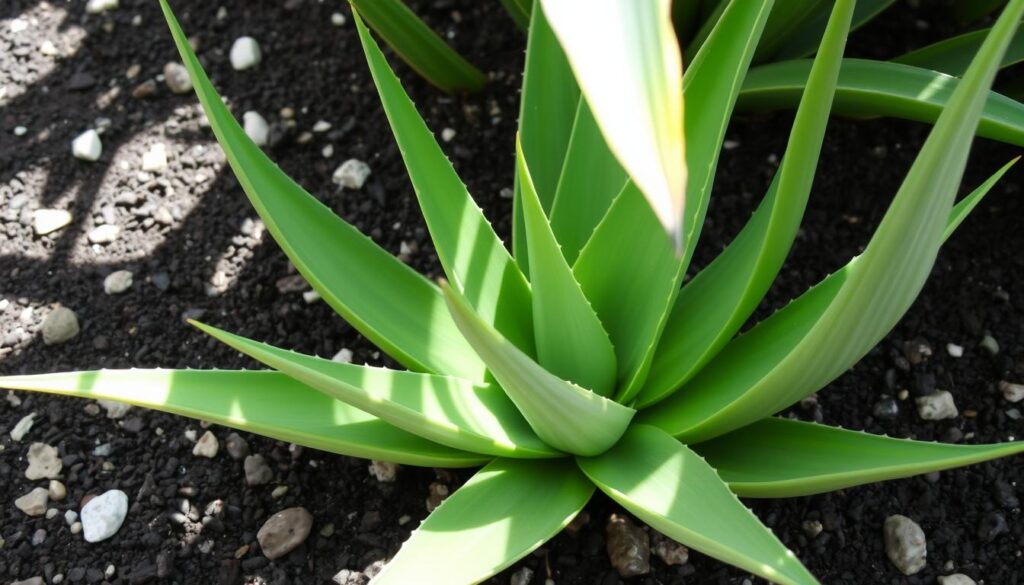
“Aloe vera plants are favored by home gardeners due to their hardiness and tolerance of infrequent watering.”
How Often Should an Aloe Plant Be Watered
Aloe vera plants need water based on their own needs, not a set schedule. Most aloe plants do well with watering once a week. But, this can change based on where they grow.
Seasonal Watering Requirements
In the fall and winter, aloe plants need less water because they grow slower. In spring and summer, they need more water. Make sure the top 2-3 inches of soil dry out before watering again.
Indoor vs. Outdoor Watering Needs
Indoor aloe plants need less water than outdoor ones. This is because indoor plants get less sunlight and wind. Indoor plants might only need watering every 2-3 weeks. Outdoor plants might need water every 7-10 days.
Factors Affecting Watering Frequency
- Pot size: Larger containers hold moisture longer, so you water less often.
- Soil type: Sandy soil dries out faster than dense soil.
- Light exposure: More sunlight means soil dries out quicker.
- Temperature: Warmer temperatures make soil dry out faster.
Watch your aloe plant’s soil moisture closely. Adjust watering as needed to keep it healthy. For more tips, check out this guide on watering snake plants. It also has useful info for aloe vera care.
Proper Watering Techniques for Aloe
Caring for your aloe vera plant is all about finding the right watering balance. To keep your succulent healthy, water it deeply. Make sure the moisture drains well before putting the plant back in its pot or water tray. This method helps remove harmful salts from the soil.
Watering your aloe from the top or bottom is fine, but avoid getting the leaves wet. If your aloe looks sick, try using filtered or distilled water. Succulents can be sensitive to minerals in regular tap water.
| Watering Tip | Explanation |
|---|---|
| Deep Watering | Allow the soil to become thoroughly saturated, then let the excess moisture drain completely before returning the plant to its pot. |
| Avoid Wetting Leaves | When watering from the top, be careful not to get the leaves wet, as this can lead to fungal issues. |
| Use Filtered Water | If your aloe appears unhealthy, try using filtered or distilled water to avoid mineral buildup in the soil. |
By following these proper watering techniques for aloe vera, you can ensure that your succulent remains healthy and thriving, no matter the season.
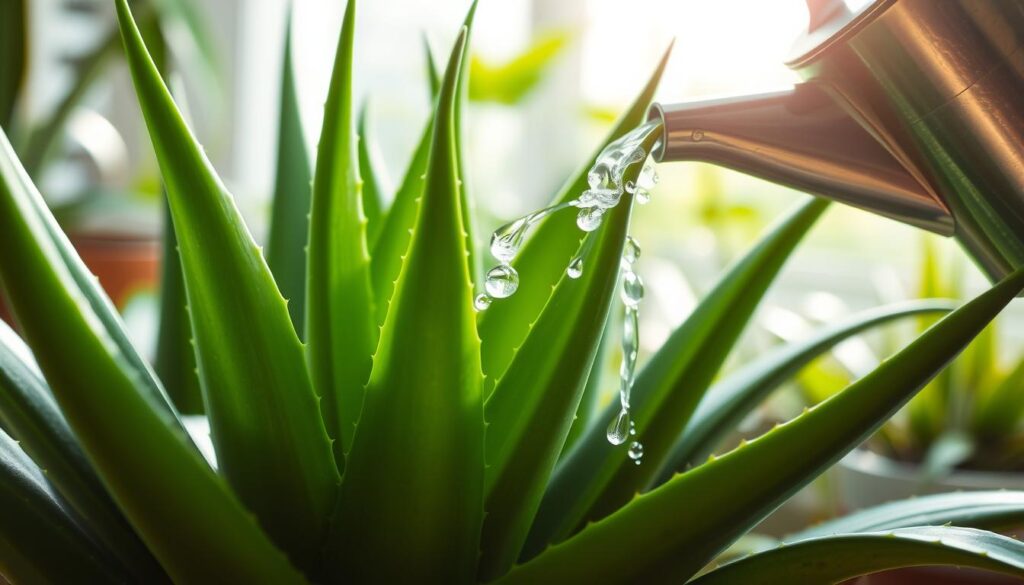
“Aloe vera only needs watering once a week, and for young plants, the watering should be done little and more often.”
Remembering these key tips will help you master the art of how to water aloe vera. This way, you can give your succulent the perfect moisture balance it needs to grow well.
Signs of Underwatered Aloe Plants
Watering aloe plants right is key to their health. If an aloe plant doesn’t get enough water, it shows signs of trouble. The leaves may look puckered and wrinkled. In bad cases, the leaves can dry up and fall off.
The leaves of a healthy aloe are smooth and slightly serrated. But when they’re stressed, they look different.
Visual Indicators
Underwatered aloe plants show clear signs of needing water. Their leaves may look dull and lose their bright green color. They might also shrink or have brown or yellow tips.
Leaf Texture Changes
As an aloe plant gets too dry, its leaves change. They become wrinkled and soft to the touch. This is because the plant can’t keep its water balance right.
Spotting these signs early is important. It helps you care for your aloe plant quickly. By fixing the watering, your plant can get back to being healthy and strong.
Watching your plant closely and adjusting how often you water is key. This keeps your aloe vera happy and healthy for a long time.
Learning the right way to water helps avoid problems and keeps your succulents thriving.
https://www.youtube.com/watch?v=i7vUH-8309o
“Aloe vera plants may need watering every week or two during summer and possibly once a month in winter if kept indoors,” – Les Pearcy, horticulture expert.
Identifying Overwatering Problems
Overwatering is a big problem for aloe vera plants. These succulents can store water in their leaves. This makes them prone to damage from too much water. Knowing the signs of overwatered aloe plants is key to keeping them healthy.
Leaf discoloration, like yellowing or browning, is a clear sign. Edema, or blistered cells, is another visual clue. Leaves that feel soft and pull away from the plant, or droopy foliage, also point to overwatering.
Look for mold in the soil and softening stems. An unpleasant smell near the aloe’s crown can also indicate root problems from too much water.
“To save an overwatered aloe, remove it from soggy soil, let it dry for a day or two, check and trim rotted roots, and replant in dry succulent soil.”
Spotting these signs of overwatered aloe plants is the first step to fixing the problem. By acting quickly and adjusting how often you water, you can help your aloe vera plant flourish.
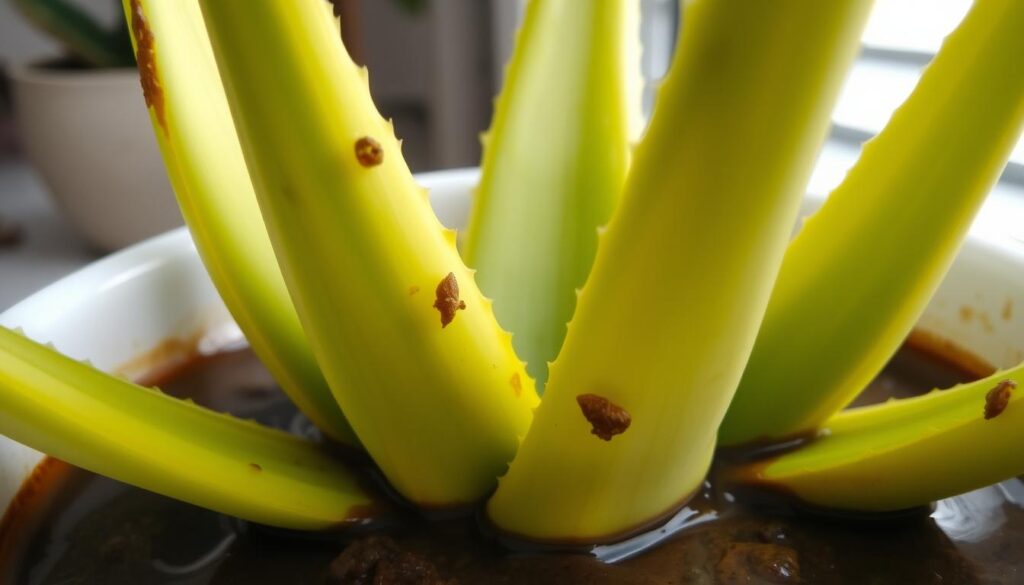
Soil Requirements and Drainage
Aloe plants love soil that drains well, just like their desert home. The best mix for an aloe plant is a mix made for succulents. It has sand, perlite, and organic stuff like peat moss or bark. This mix helps the roots breathe and drain water well.
Best Potting Mix Compositions
To make your own mix, mix equal parts of:
- Coarse sand or perlite
- Peat moss or coco coir
- Bark or compost
This mix is perfect for aloe plants. It drains well and gives them the nutrients they need.
Container Selection Tips
Choose a container with lots of holes for water to drain. Unglazed clay pots are great because they let water evaporate. For tall pots, add a 2-inch layer of small gravel or pebbles at the bottom. This helps with drainage.
| Soil Requirement | Ideal Composition |
|---|---|
| Aloe Plant Soil | Equal parts sand, perlite, and organic matter |
| Succulent Potting Mix | Equal parts coarse sand, peat moss, and bark |
“Proper soil and drainage are key to keeping aloe plants healthy and thriving.”
Light and Temperature Requirements
Getting the light and temperature right is key for aloe plants to grow well. These tough plants love bright, indirect sunlight and do best in temperatures between 55°F and 85°F.
For indoor aloes, a spot near a kitchen window works great. Outdoor plants need at least six hours of direct sun each day. If it’s too dark, grow lights can help.
Aloe plants don’t like drafts or big temperature changes. Keep them away from cold doors and windows. If it gets too cold outside, bring them inside to keep them safe.
| Light Requirement | Temperature Range |
|---|---|
| Bright, indirect sunlight (6-8 hours daily) | 55°F to 85°F (ideal) |
| Supplemental grow lights if natural light is lacking | Avoid temperatures below 50°F |
By giving aloe plants the right light and temperature conditions, they’ll grow well. This lets them show off their beauty in your home or garden.
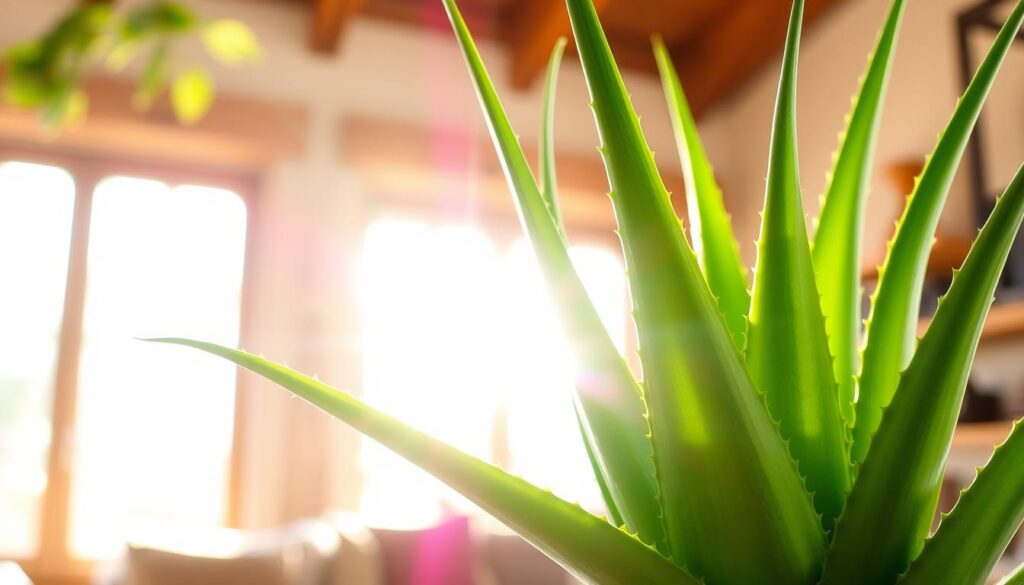
“Aloe vera plants are known for their resilience, but they do have specific light and temperature needs to truly flourish.”
Winter Care for Aloe Plants
When it gets colder, aloe plants slow down and need special care. They go into a semi-dormant state. It’s important to take good care of these succulent plants to keep them alive and healthy when spring comes.
Reduced Watering Schedule
In winter, aloe plants need much less water than in the growing season. Cut back on watering to about half. Make sure the soil doesn’t get too wet, as it can cause root rot.
Temperature Management
Aloe plants don’t like cold and can get damaged or die if it’s too chilly. If your aloe plants are outside, bring them inside before the first frost. Keep them in a warm, bright spot to stay healthy all winter.
For indoor aloe plants, keep the temperature between 60-85°F (16-29°C) in winter. Don’t put them near cold windows or heaters, as sudden changes can stress them out.
| Winter Care Recommendations for Aloe Plants | Optimal Range |
|---|---|
| Temperature | 60-85°F (16-29°C) |
| Watering Frequency | Once a month or less |
| Humidity | Around 40% |
| Fertilization | None required |
By following these tips for aloe plant winter care and succulent cold tolerance, you can help your aloe plants make it through the cold months. They’ll be ready to thrive when spring arrives.
Common Aloe Plant Problems and Solutions
Aloe vera plants are known for their toughness but can still face many issues. These include pests and diseases that need quick attention. Aloe vera plant care is key to keeping them healthy and strong.
One big problem is overwatering. These plants don’t like too much water and can get root rot. This makes their leaves turn mushy and weak. To avoid this, water them only when really needed, usually every two to three weeks. Make sure the soil drains well too.
- Overwatered aloe plants show droopy, mushy leaves and faded colors.
- Seasonal changes can affect how often to water, as plants lose moisture slower in winter.
- Poor drainage in the soil can lead to overwatering and root rot.
Underwatering is another issue, causing leaves to wilt and grow slowly. Finding the right balance is crucial for a healthy plant.
Pests like mealybugs, spider mites, and snout beetles can harm aloe plants. They make leaves turn yellow and develop webs. Regular checks and quick treatment with insecticides or natural solutions are needed.
Aloe plants can also get diseases like aloe rust, sooty mold, and basal stem rot. These cause discoloration and rot. Good air flow, avoiding leaf water, and fungicides can help prevent these issues.
Getting advice from a local plant expert can be very helpful. They can offer specific tips for your aloe plant care. By being proactive, you can keep your aloe plants healthy and thriving.
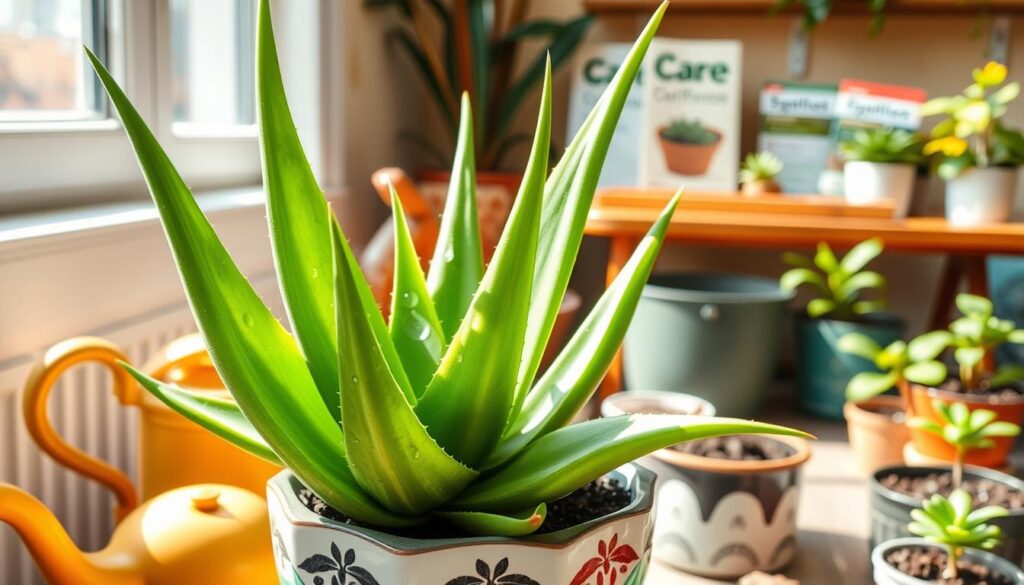
Fertilization and Nutrition Guide
Aloe plants don’t need much food and can be fertilized lightly. Too much fertilizer can harm them, making them weak and leggy. The best time to feed your aloe is in the spring, just before it starts growing again.
For the best nutrition, use a houseplant or succulent fertilizer, but only at half-strength. Always follow the instructions on the package to avoid harming your plant. Feed your aloe aloe plant fertilizer only when needed, as they prefer a simple diet.
Aloe vera grows well in zones 10 through 12 and can thrive outdoors in warm places. Even indoor aloe plants, grown as succulents, need very little succulent nutrition. Proper fertilization helps them grow strong and healthy, with plump leaves and many offsets.
| Fertilizer Type | Application Frequency | Dilution Rate |
|---|---|---|
| Houseplant Fertilizer | Twice during the growing season | Half-strength |
| Succulent-and-Cactus Fertilizer | Twice during the growing season | Half-strength |
| Organic Materials (Compost, Worm Castings) | Early spring and early summer | N/A |
Feeding your aloe too much or at the wrong time can cause problems. This includes root burn, leggy growth, brown spots, or mineral deposits. Stop feeding in fall and winter when aloes are dormant.
“Aloe plants are low maintenance and almost indestructible, thriving in dry conditions with sandy or lean soil.”
Pruning and Maintenance Tips
Keeping your aloe vera plants healthy is key. Regular pruning helps remove dead leaves and encourages new growth. It also prevents overcrowding.
When to Remove Dead Leaves
Check your aloe vera plant often for dead leaves. Use your fingers to gently pull off brown, brittle, or yellow leaves. Start with the older leaves and move towards the center.
Don’t cut the younger, fleshy leaves in the center. They are the healthiest and most important for the plant’s growth.
Propagation Methods
Aloe vera plants produce offsets or “pups” at the base. These pups can be separated and grown into new plants. Remove the pups from the soil and let the cut end callus over for a few days.
Then, repot them in a well-draining succulent propagation mix.
“Proper aloe vera pruning is essential for maintaining the health and appearance of your aloe vera plant. By removing dead leaves and propagating new plants from offsets, you can ensure your aloe vera thrives for years to come.”
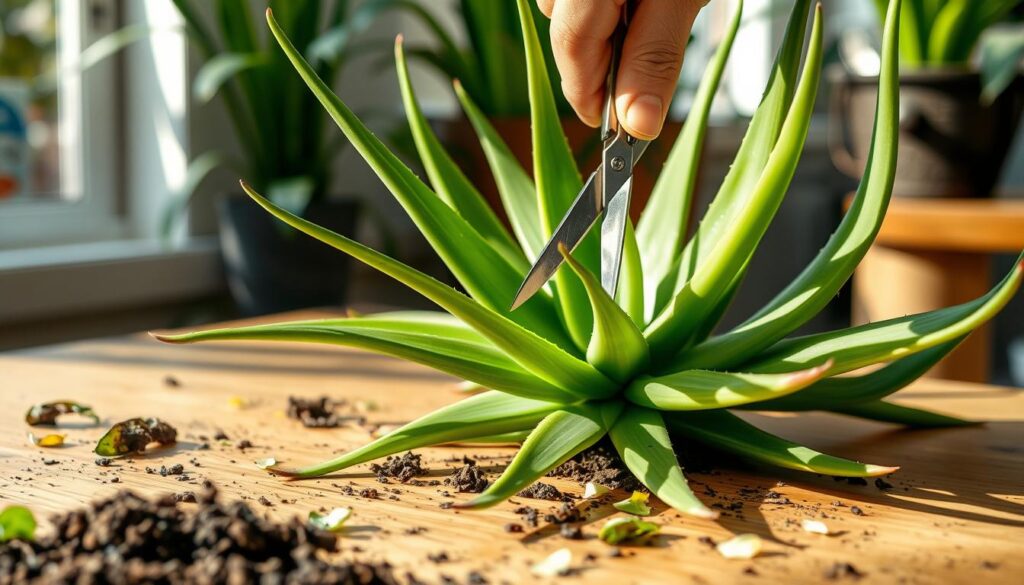
Always use clean, sterilized pruning tools. This prevents pests or diseases from spreading. With care and attention, your aloe vera will grow lush and vibrant. It will also provide a lot of soothing, medicinal gel.
Conclusion
Caring for aloe vera plants is all about finding the right balance. You need to water them when the soil is dry, give them bright indirect light, and use a potting mix that drains well. This prevents problems like too much water or root rot.
Changing how often you water them with the seasons helps them grow well. For example, you should water them less in winter.
Watching for signs of too little or too much water is crucial. Also, quickly dealing with pests or diseases helps aloe vera plants thrive indoors or outdoors. They add beauty and have practical uses for years.
With the right aloe vera plant care, these plants are easy to care for. They become a great addition to any home or garden.
By following the best aloe vera plant care and succulent care guide, you can enjoy their beauty and health benefits. These plants offer unique looks and soothing medicinal properties.
